On a cold and wet Winters night, a group of food-bloggers partook a Sake Masterclass. Executive chef, Raita Noda, of Ocean Room teamed up with sake master Toshi Maeda and devised a 6 course meal with matching sake. Toshi’s goal is to educate Australians about the different grades of Sake and bring about an appreciation of this unknown beverage. He has a japanese izakaya-style restaurant “Sake & Grill MAEDAYA” in Richmond (VIC) where he stocks over 60 types of premium Nihonshu, Shochu, Umeshu & Japanese local beer and serves a vast selection of japanese food to be had with these drinks. I think there not much known about Sake here in Australia and there aren’t that many opportunities where we can appreciate premium quality Sake. So I felt extremely lucky to be invited along to this event to broaden my limited knowledge of Sake.
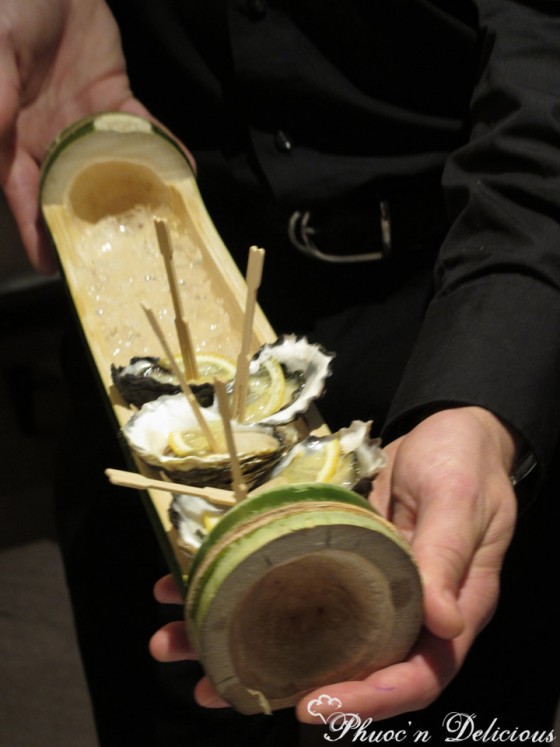 We started the night off with some oysters as we waited for the class to begin. They were nice and fresh and it was a shame I couldn’t have more. Toshi starts off the class by telling us a bit about himself, introduces us to the 6 sakes we’ll be tasting and goes on to explaining that the quality or grade of sake is determined by a system called Seimaibuai. This system provides a percentage to indicate the amount of rice that remains unpolished. The polishing process is essential as it removes fats, proteins and minerals from the rice which can reduce the quality of the sake. The more you polish the rice, the higher the grade of sake; that is, the smaller the percentage the better. Other characteristics of sake are dryness and sweetness, which are measured by a system called Nihonshudo (Sake Meter Value; SMV). Essentially, the higher the number the dryer the sake and the lower the number the sweeter it is.
We started the night off with some oysters as we waited for the class to begin. They were nice and fresh and it was a shame I couldn’t have more. Toshi starts off the class by telling us a bit about himself, introduces us to the 6 sakes we’ll be tasting and goes on to explaining that the quality or grade of sake is determined by a system called Seimaibuai. This system provides a percentage to indicate the amount of rice that remains unpolished. The polishing process is essential as it removes fats, proteins and minerals from the rice which can reduce the quality of the sake. The more you polish the rice, the higher the grade of sake; that is, the smaller the percentage the better. Other characteristics of sake are dryness and sweetness, which are measured by a system called Nihonshudo (Sake Meter Value; SMV). Essentially, the higher the number the dryer the sake and the lower the number the sweeter it is.
He told us that 75% of the total sake production in Japan is classified as non-premium; Futsushu, and the remaining 25% is considered “Premium”; Tokuteimeishoshu. Amongst the premium sakes, it is further broken down into 6 grades: Honjozu, Junmai, Ginjo, Junamai Ginjo, Daiginjo and Junmai Daiginjo (from “lowest” quality to the highest).
Honjozo – A small amount of distilled alcohol is added to this sake resulting in a sake which has a smoother, lighter and earthy flavour with the extra fragrance of the rice. This has a seimaibuai of 70% or less.
Junmai – This sake is made from 100% rice and contains no additives such as alcohol, sugar and starch. Junmai once was required to have a seimaibuai of at least 70% but this is no longer applicable. This sake is typically medium bodied, rich, and has a clean, smooth flavour.
Ginjo – This sake is made with extra elements such as Ginjo yeast and is produced with a low temperature and long term fermentation. Generally, Ginjo has a nice fruity and flowery fragrance with a delicate flavour. Ginjo without any additives such as alcohol is called Junamai Ginjo. This sake has at least a seimaibuai of at least 60% or less.
Daiginjo – The highest grade and most expensive type of sake. It is commonly lighter, more fragrant, delicate and fruitier. Daiginjo without any additives is called Junmai Daiginjo. This sake must have at least 50% or less seimaibuai.
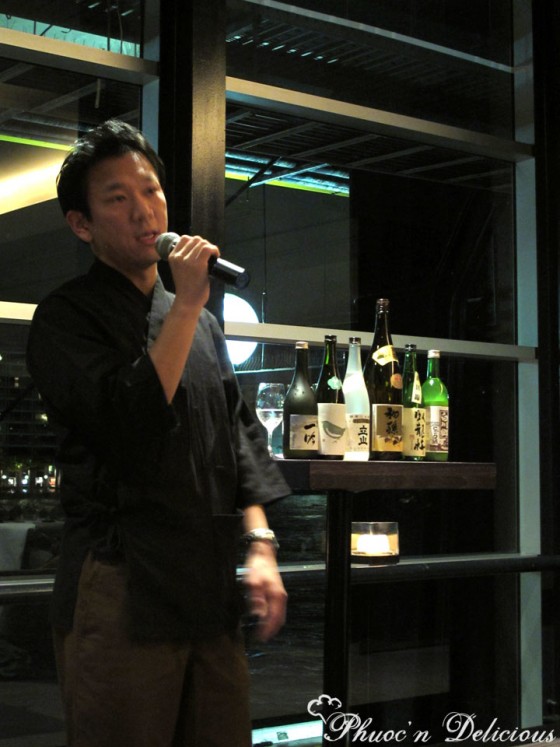
Toshi Maeda
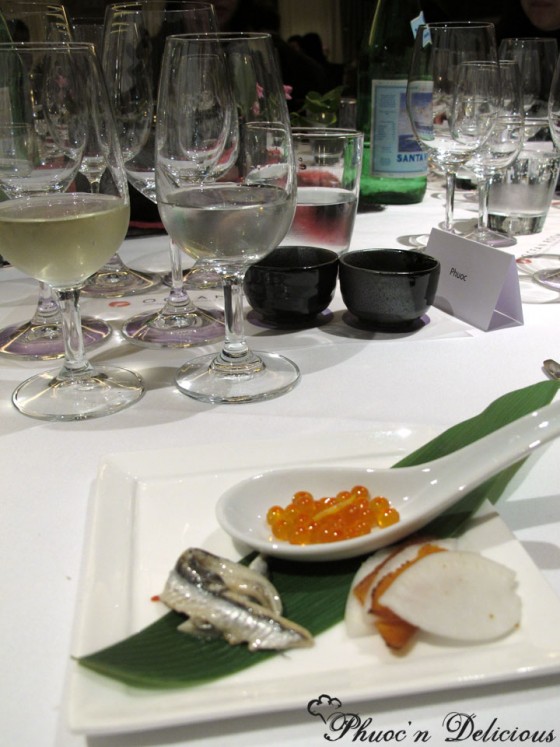
First off we compared the taste of some japanese condiments with some white wine and sake. Whilst I’m no wine connoisseur, I thought the wine was crisp and was it paired reasonably well with the condiments, this was until I tasted them with the sake. The sake was mellow and carried the flavours of the condiments exceptionally; allowing them to linger around on the palate.
So begins our Sake Masterclass. It was interesting to see how different sakes were matched with our meals, how different each grade of sake tasted and how the temperature can affect the way a sake tasted. Please excuse me as I don’t remember all the sakes off by heart but I will try my best to recall what I have learnt.
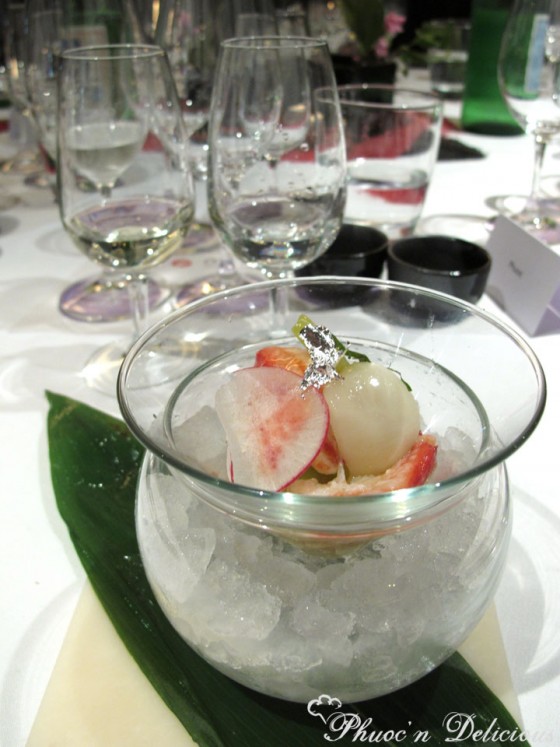
The first course was Sake jelly king crab. Alaskan king crab was cooked using the sous-vide method which resulted in a succulent piece of crab which packed in a lot of flavour and tasted so fresh. It was served with cured white turnips and sake and sour plum jelly. There was a slight tang from the turnips and I didn’t notice any strong alcoholic jelly at all. A fantastic way to start the night with something light.
The sake we had to match this course was Eikun Ichigin Junmai Daiginjo (Kyoto) (S – 35%) and it was served chilled. This is the ultimate premium sake; having has won the gold medal for 10 years running at the Japanese New Sake Awards. I found it to have a very sweet fruity smell and a very smooth, clean taste; it didn’t taste harsh at all. I enjoyed this sake the most during the night.
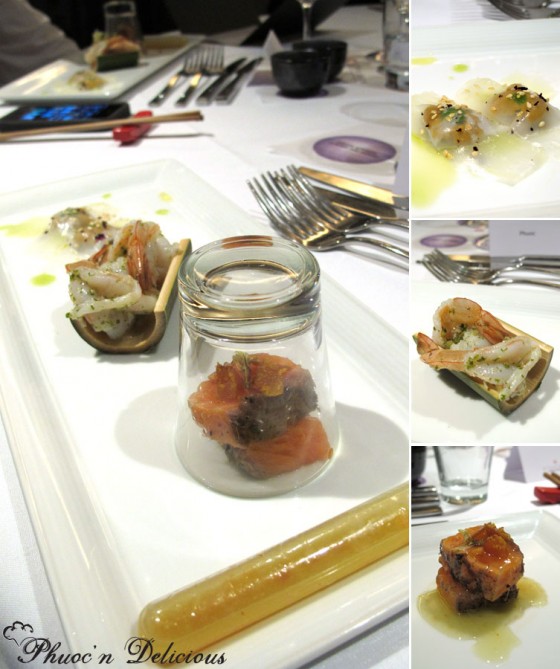
Most probably the highlight for everyone on my table was featured on this dish, East meets West. There were three components to this dish; (from top to bottom) fresh cuttlefish and Tasmanian sea-urchin ravioli with coriander infused oil, lightly poached Arai Crystal Bay prawns sashimi with green chilli and shiso salsa and flash sakura smoked ocean trout with houji-tea and ocean trout roe vinaigrette. This was my first time experiencing sea urchin and unfortunately it probably wasn’t the best way to do so because all I could taste was the cuttlefish and coriander oil; the texture of the cuttlefish was interesting as it was slippery and rubbery. The prawns were nice and had a very subtle kick to it but being the chilli fan that I am, I would have liked it even more if the heat was turned up just a notch. When I lifted up the glass to tuck into the trout, for some reason I pointed it to my face and to my surprise welcomed a puff of smoke. The trout was succulent and I loved the accompanying vinaigrette as it wasn’t too tangy.
This dish was matched with Niwano Uguisu Tokubetsu Junmai (Fukuoka) (S – 60%) and was served at room temperature. The refined smooth taste was no longer present instead it was starting to taste like alcohol now…
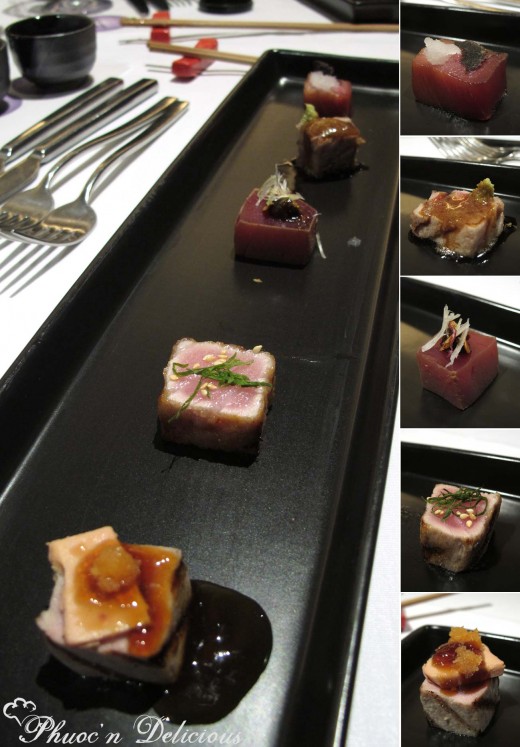
One of Raita Noda signature dish made its way into this 6 course degustation. The Blue fin tuna creation features different parts of tuna served 5 different ways with 5 different condiments; (from top to bottom) marinated chutoro with truffle caviar and spicy daikon, oil-blanched toro with fresh wasabi, soy form and kombu, zuke (?) akami with dry natto, negi miso and leek jullienne, seared toro with shiso jullienne, sesame and lime juice and seared akami with foie gras, ponzu jelly and momiji radish. My favourite creation was the zuke akami, I have been warned about natto before but this was the dry version so I guess the flavour isn’t as intense as the wet counterpart, the tuna was soft and melted in my mouth. Every tuna piece was morish and I enjoyed how each creation was different to one another in terms of taste and texture. [Toro is the fatty belly portion, akami is the leaner portion that is commonly used in sushi and chutoro is in between the two in terms of fattiness and position.]
Tateyama Junmai Ginjo (Toyama) (S – 59%) was also served at room temperature. It was extremely difficult for most of the females on my table to finish this off as we found it to be very harsh.
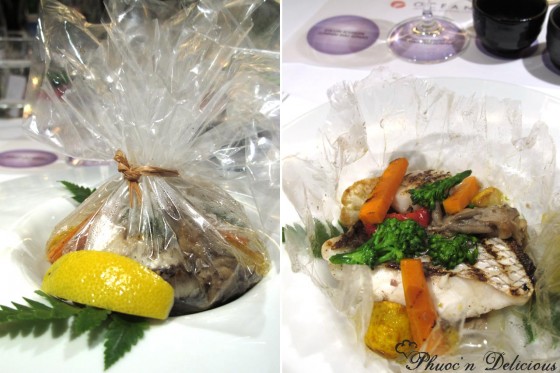
Now we move onto the more substantial food items. We were presented with a cellophane bag steamed pink snapper which was served with scallops, tofu and vegetables in a sake and yuzu butter; extra yuzu zest was scattered over our dish but I think it needed something more than that for an extra citrus hit. Everything was cooked to perfection and the snapper fillet was very succulent.
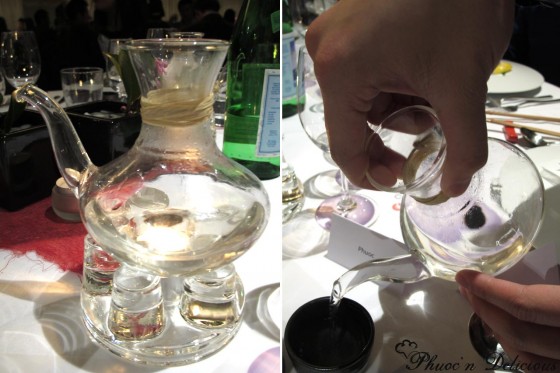 For this dish, Hatsumago Karakuchi Honjozo (Yamagata) (S – 60%) was served to us warmed. I have always been fascinated about the affect of different temperatures on the taste of a sake. One of the ways to serve sake hot is to place it on a stand which has a candle in the middle to keep the sake warm. Ideally high-grade sakes are not served hot as the aroma and taste will be lost. When serving sake, you are to pour every one’s cup but your own and you must ensure that every one’s cup is full at all times unless they place it downwards (for when they don’t want anymore). I found that the taste of the sake was smoother when warm and when it had cooled down a bit, I felt that there was a slight tingling sensation on the tip of my tongue and it wasn’t as smooth anymore.
For this dish, Hatsumago Karakuchi Honjozo (Yamagata) (S – 60%) was served to us warmed. I have always been fascinated about the affect of different temperatures on the taste of a sake. One of the ways to serve sake hot is to place it on a stand which has a candle in the middle to keep the sake warm. Ideally high-grade sakes are not served hot as the aroma and taste will be lost. When serving sake, you are to pour every one’s cup but your own and you must ensure that every one’s cup is full at all times unless they place it downwards (for when they don’t want anymore). I found that the taste of the sake was smoother when warm and when it had cooled down a bit, I felt that there was a slight tingling sensation on the tip of my tongue and it wasn’t as smooth anymore.
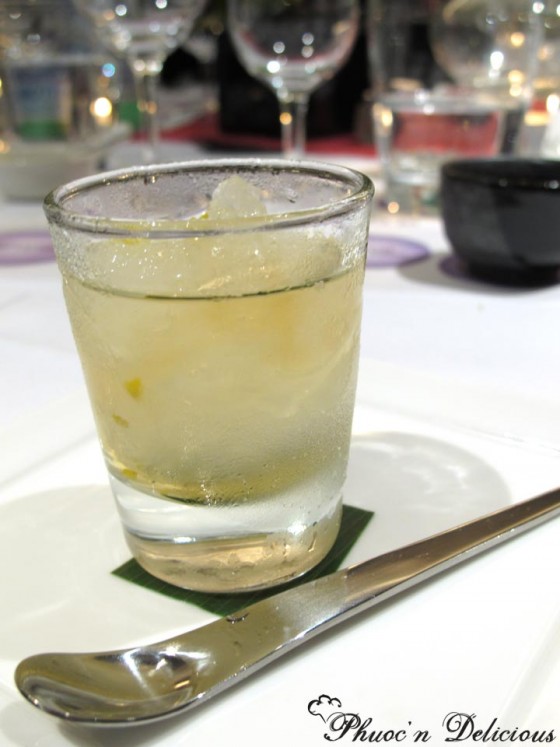 We were given a cleanser before we commenced onto our final meat dish for the night. This cleanser was a semi frozen sake shot with a touch of umeshi plum wine and yuzu zest. The alcoholic components used in this cleanser was Tamanohikari Junmai Touketsushu (Kyoto) and Uguisu Tomari Plum Wine (Fukuoka). Although it was refreshing, it did pack quite a punch. In my opinion, this would be fantastic to serve this to your friends during the warmer seasons. I said to the guest on my table that we should throw out the jellos shots and replace them with frozen alcoholic slushy shots instead. (Remember, you heard it from me first!)
We were given a cleanser before we commenced onto our final meat dish for the night. This cleanser was a semi frozen sake shot with a touch of umeshi plum wine and yuzu zest. The alcoholic components used in this cleanser was Tamanohikari Junmai Touketsushu (Kyoto) and Uguisu Tomari Plum Wine (Fukuoka). Although it was refreshing, it did pack quite a punch. In my opinion, this would be fantastic to serve this to your friends during the warmer seasons. I said to the guest on my table that we should throw out the jellos shots and replace them with frozen alcoholic slushy shots instead. (Remember, you heard it from me first!)

After all the seafood we’ve had throughout the night, it was great to welcome a meat dish with both arms wide open. We had sansho pepper roasted angus beef with sake scented jus which was served with flamed-seared Roquefort cheese. The angus beef was super juicy and just what I needed to end this meal (besides desserts of course). I didn’t actually realise the cheese was Roquefort cheese until I had it and thought it tasted a bit funky.. I’m not a huge blue cheese fan but didn’t mind this at all, I only had small portions of it and thought it was ok with the beef; it was truly something different that’s for sure!
We were served Garyubai Junmai Ginjo (Shizuoka) (S – 55%) with this dish and honestly I can’t remember too much about this sake as it was getting very late and all they were all starting to taste the same at this point.
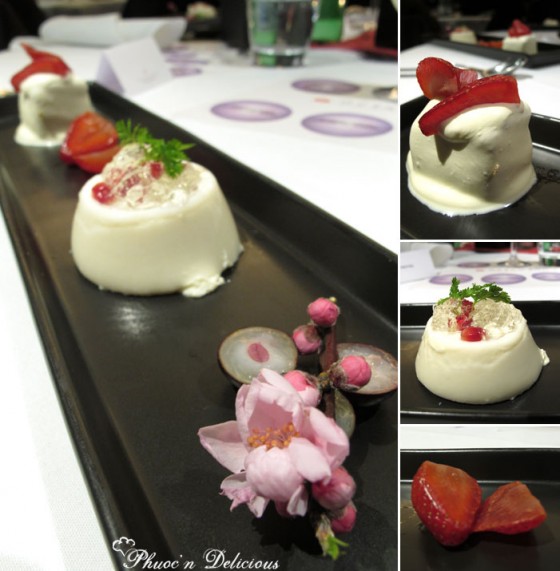
I was very excited about dessert ( Imean, who doesn’t get excited about desserts?) and intrigued how sake would be incorporated into it. The Sake Abstract featured sake-kasu blancmange with daiginjo jelly, fresh jobocabla, chiffon cake with sake infused creme fraiche and shochu marinated strawberry. I loved the chiffon cake the most (I was able to score a second helping as one of the guest on my table left early), it was fluffy and the creme fraiche was light, creamy and sweet. At first I thought we were served pannacotta but when I took the first bite I found it wasn’t sweet and creamy as I had imagined it to be; it was kind of like a milk jelly. The daiginjo jelly was very potent and I felt it didn’t work well with the blancmange; perhaps if the alcohol was turned down a bit in the jelly and the blancmange was a little sweeter, then it could make for a better dessert.
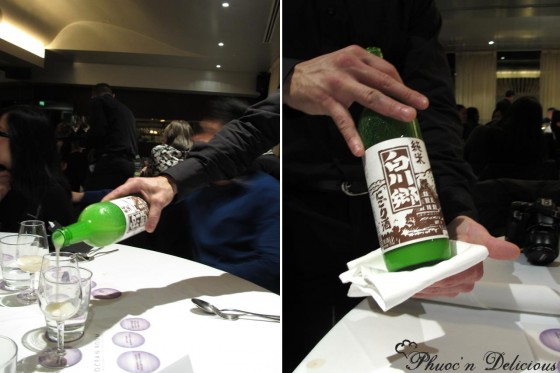 We were served with a very interesting “dessert” sake . The Shirakawago Junmai Nigorizake (Gifu) (S – 70%) had a SMV of -25 so naturally I thought it was going to be sweet, especially since it was going to be served with our desserts, but I was extremely wrong. Nigorizake roughly translates to “cloudy sake” and this sake definitely lives up to its name. During the brewing process, some of the rice solids are left suspended in the sake creating this distinct cloudy appearance.
We were served with a very interesting “dessert” sake . The Shirakawago Junmai Nigorizake (Gifu) (S – 70%) had a SMV of -25 so naturally I thought it was going to be sweet, especially since it was going to be served with our desserts, but I was extremely wrong. Nigorizake roughly translates to “cloudy sake” and this sake definitely lives up to its name. During the brewing process, some of the rice solids are left suspended in the sake creating this distinct cloudy appearance.
Some final remarks about Sake. There is no absolute golden rule about what temperature to serve sake, it is dependant on the mood and preference of the drinker, the quality of sake, the season and the food it is matched with. Generally the most premium sakes are served chilled as heating them up would affect their overall complex aromas and flavours. It is best to consume sake immediately after opening it but if this is not possible, you could keep it in the fridge for a few days if sealed completely. You also wouldn’t want to keep a bottle of sake lying around for long periods of time, it’s not like some wines where it improves with aging, so once you receive a bottle, invite some friends over and be merry.
For those who are interested in purchasing some sake or other japanese alcoholic beverages, Toshi has an online store where you can find a vast range of premium sakes, shochu (japanese spirits), umeshu (plum wine) and japanese beers.
Phuoc attended The Sake Masterclass held at Ocean Room as a guest of Wasamedia.
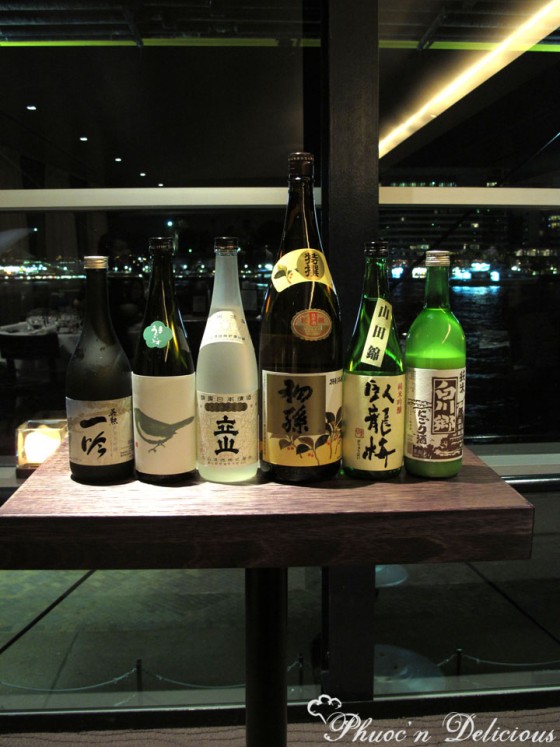

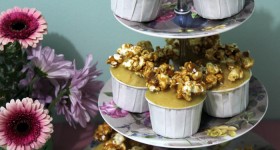
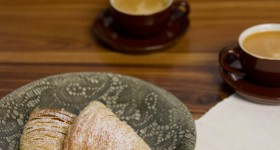
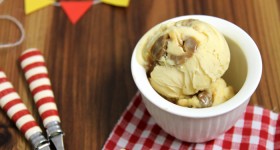
lol at the description of Roquefort as funky! I happily scored a double portion of cheese but I’m still envious you got double desserts!
hahaha @ funky! i loved the tuna 5 ways zomg chutoro so much <3
So funny how you guys went from gorgeous sushi set-ups to ‘HEY PRESTO STEAK’. That dessert looks amazing… omnomnom..
Mmmm the tuna 5 ways was amazing, wish I could have had more. Haha good work scoring another piece of cake!
yummo! I like that tuna 5 ways!
Hmm yes I think Roquefort is a bit funky as well =P The food looks amazing and I really want to try that sake you had with the Alaskan crab course, most sakes that I’ve tried are a bit harsh for me
Oh so much cool looking food. I really like the look of the Tuna plate and flame grilled cheese on any plate has to be good.
i’ve never been a fan of sake but perhaps i haven’t been trying the right ones. sounds like a great event to try and appreciate sake. 🙂
you are becoming quite the food photographer!
Great seeing you that night! I so want more crab.
Helen: Next time you could have my share of funky cheese as well 😛
Suze & Steph: They need bigger portions of the tuna creation
Margaret: I swear I needed some protein after all that seafood though!
Anh: Tuna is the best!
Jacq & Simon: Next time when choosing sake, keep in mind of that Seimaibuai number, the lower the better (but the more expensive)! 😀
Mark: Normally I wouldn’t pass down on grilled cheese but I could only take blue cheese in small portions..
Richard: Thanks! I’m sure you’ll do a better job though.
Jen: Crab was delicious… And it was great seeing you again 🙂
check out the colour in the beef! looked like alot of fun!
I’d only had blue cheese and steak once or twice before and I was pleasantly surprised, it actually works very nciely! Sake sake sake!